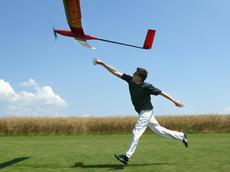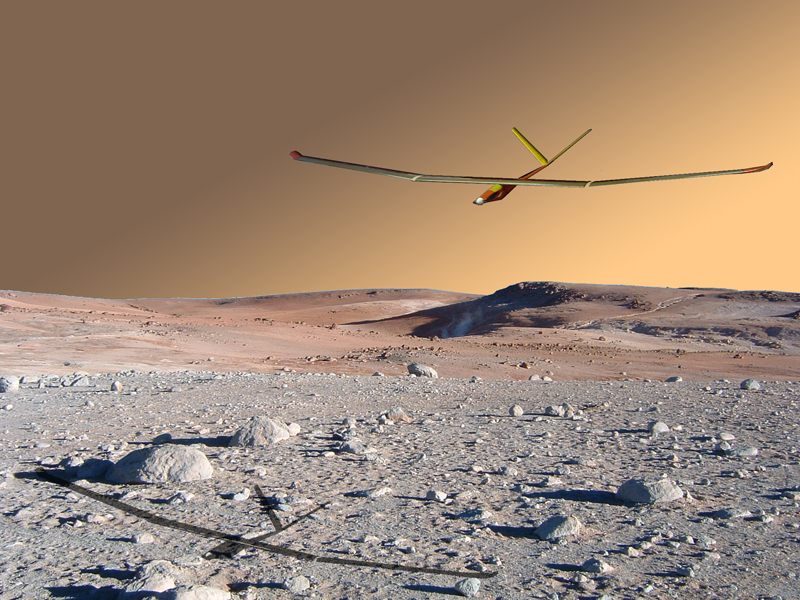Gliding with the sun
ETH Zurich engineers tried to set a new non-stop flight record with the solar-powered glider “Sky Sailor”. Wind and clouds wrecked their plans. The attempt was valuable nevertheless.

There were big plans for the solar-powered glider "Sky Sailor" on that Wednesday morning in late July: a world record for solar aircraft. The unmanned glider was sent on its journey from the Müswangen (LU) model airfield at 11 o’clock. The aim was for the plane to remain airborne for 24 hours, driven only by solar energy. But it was not to be. The aircraft was forced to land again after sunset. The dream of a world record was a mirage.
Unfavourable weather
André Noth, project leader from the Autonomous Systems Laboratory of ETH Zurich sums it up briefly and succinctly: “We had too many clouds and too much wind during the day.” The clouds prevented the accumulator, which is fed with surplus solar energy, from charging fully. This would have been needed to allow the aircraft’s motor to run during the hours of darkness in the night. The wind also repeatedly forced the aircraft below the programmed flight altitude during the day. Climbing to a height of 200 to 300 metres above the ground also used up too much precious energy.
Noth is satisfied nevertheless, and says the knowledge gained is valuable for future plans. The aircraft was able to stay in the air for 10 hours, during which it travelled a distance of 330 kilometres. The principle had proved successful.
Designed for Mars exploration
Sky Sailor was launched ambitiously three years ago. The European Space Agency (ESA) commissioned a feasibility study from ETH Lausanne in 2004 to find out whether unmanned solar aircraft would be suitable for exploration flights over Mars. In contrast to NASA, the ESA focused on small, lightweight aircraft that can use solar energy to remain airborne almost indefinitely. On the other hand NASA studied gliders flying for at most 10 hours at a time but carrying bigger loads in return.
Although the Lausanne researchers had demonstrated feasibility, the ESA cancelled the project due to lack of funding. The scientists involved, including André Noth, now at Professor Roland Siegwart’s Autonomous Systems Laboratory at ETH Zurich, decided to continue working as a two-man team. Noth invested a large amount of time using mathematical models to run through different variants until he found the ideal type of aircraft. To implement it, Noth, who is from the Suisse Romande, called in retired model aircraft constructor Walter Engel from Einsiedeln, who is very experienced in building ultra-lightweight gliders. This prototype of the Sky Sailor is the result of the collaboration between theory and practice.
Only the most expensive solar cells are good enough
The lightweight weighs only 2.5 kilos and has a wingspan of 3.2 metres. 216 silicon solar cells cover an area of half a square metre on the upper surface of the wings. The solar cells must be flexible to conform optimally to the wing shape but must still be highly efficient. The cells that were chosen for this reason are among the most expensive, costing 20'000 Swiss francs per square metre. They yield a maximum power of 90 watts. The aircraft consumes 16 watts when flying straight ahead. The solar cells supply the motor, the on-board electronics and the battery, which weighs 1.2 kilos and is almost half the weight of the aircraft. The battery is responsible for supplying electricity to the motor and on-board electronics at night. This is a limiting factor, in spite of using lithium-polymer accumulators, because it is still not light and efficient enough.
The aircraft has a built-in autopilot that flies along a programmed flight path. On-board sensors monitor speed, height and angle of flight. A global positioning system (GPS) determines the exact position of the Sky Sailor. The electronic equipment includes a communication device to send and receive data to and from the ground respectively. The ground crew can switch in a remote controller to land the solar aircraft safely.
Waiting for optimum conditions
Noth has attempted three 24-hour flights with the Sky Sailor prototype, but none has succeeded so far. However, measurements confirm that a non-stop flight would be possible. Noth says: "Optimum conditions are needed to break the world record." This requires cloudless weather with no wind and a short night around the time of the summer solstice between late May and the end of June. He will begin a new attempt next year at the earliest.
A Mars mission is out of the question for Noth at present. He says Sky Sailor could also be used on the Earth. In this respect the researcher has in mind a flying fire alarm that circles over areas where there is a risk of forest fires and can use an infrared sensor to detect where a fire starts. The aircraft could relay all the necessary data directly to the fire brigade. "That would save valuable time and money." Larger solar gliders that carry loads could be used as flying mobile phone antennas. The engineer is certain that "There is great interest in flying applications."









READER COMMENTS